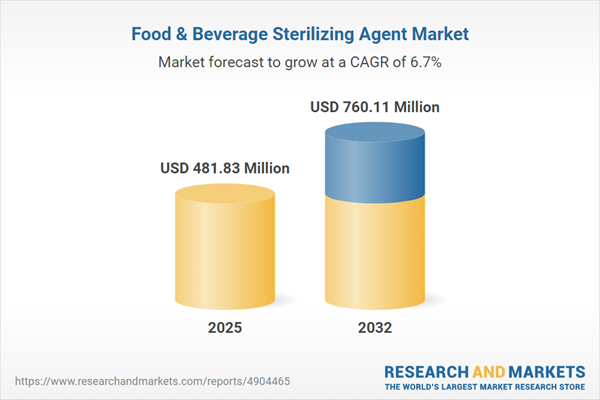Speak directly to the analyst to clarify any post sales queries you may have.
Senior executives within the food and beverage sector are proactively advancing their sterilization approaches to streamline operations and comply with stricter industry requirements. As global complexities grow, enhanced sterilization has become an essential element in ensuring continuity and minimizing potential disruptions.
Market Snapshot: Food & Beverage Sterilizing Agent Market
The global food & beverage sterilizing agent market is projected to achieve USD 760.11 million by 2032, rising from USD 451.05 million in 2024 at a CAGR of 6.74%. This consistent growth reflects rapid adoption of advanced sterilization technologies, evolving regulatory expectations, and increased industry emphasis on robust supply chain compliance. Companies across the sector are adopting innovative agents and developing adaptive strategies as they operate in diverse international markets. As standards for safety and sterility advance, organizations can better safeguard against risks, exceed customer quality demands, and satisfy regulatory obligations within intricate supply networks.
Scope & Segmentation in the Food & Beverage Sterilizing Agent Market
This market report delivers a focused analysis tailored for decision-makers seeking clarity on technology choices, sector-specific trends, and regional priorities. Strategic segmentation supports investment planning and ensures operational alignment with compliance mandates across the food and beverage ecosystem.
- Sterilization Agent Type: Chemical agents, such as chlorine dioxide, peracetic acid, hydrogen peroxide, sodium hypochlorite, and ozone, address diverse processing environments. Non-chemical options—including high-pressure processing, gamma irradiation, electron beam treatment, steam, and ultraviolet sterilization—offer alternatives where chemical use is restricted or operational flexibility is needed.
- Form: Gas, liquid, and vapor formulations facilitate integration with both renovated and new production lines, supporting upgrades and expansions without disrupting existing workflows.
- Application: Uses include equipment sanitization, packaging sterilization, surface disinfection, and water treatment, supporting end-to-end food safety and quality assurance.
- End Use Industry: Sectors such as bakery, confectionery, beverage, dairy, meat and poultry, as well as fruit and vegetable processing, each have unique sterilization needs shaped by operational complexity and regulatory scrutiny.
- Region: The Americas, Europe, Middle East & Africa, and Asia-Pacific exhibit distinct development trajectories due to variations in regulation, infrastructure, and adoption of sterilization innovations.
- Companies Profiled: Leading players include Ecolab Inc., STERIS plc, Solvay S.A., Diversey Holdings Ltd., Evonik Industries AG, Lonza Group AG, 3M Company, Clariant AG, DuPont de Nemours Inc., and Ashland Global Holdings Inc., with analysis of their approaches to innovation, partnerships, and market expansion.
Key Takeaways for Senior Decision-Makers
- Adopting a mix of chemical and physical sterilization technologies enables swift response to policy changes and industry shifts.
- Implementing ultrasonic and high-pressure processing supports greater sustainability, boosts productivity, and prepares facilities for future regulatory transitions.
- Comprehensive sterilization protocols drive improved process monitoring and build stronger audit readiness, thereby increasing confidence among partners and regulatory stakeholders.
- Enhanced packaging sterilization emerges as a priority for traceability and compliance, especially in global and multi-phase distribution networks.
- Strategic collaboration with specialized technology and chemical suppliers accelerates solution customization to meet evolving compliance landscapes.
- Regionalized adoption strategies for sterilizing agent technologies optimize resource deployment and budget efficiency across varying operational conditions.
Tariff Impact and Strategic Response
Recent U.S. tariff adjustments have elevated input costs associated with sterilizing agents. Senior leaders are mitigating these costs by refining procurement approaches, emphasizing local sourcing, and building new technology alliances to stabilize supply channels and reduce risks connected to international trade.
Methodology & Data Sources
Insights are derived from comprehensive quantitative market analysis and direct interviews with procurement and operations executives across the food and beverage industry. This blended research model ensures findings address both high-level market dynamics and practical executive needs related to modern sterilization solutions.
Why This Report Matters
- Empowers strategic planning by offering benchmarks for evaluating current and next-generation sterilization options, ensuring informed process upgrades.
- Delivers timely analysis of shifting regulatory trends and technology directions, enabling proactive risk and investment management across the supply chain.
- Bolsters leaders’ capacity to build resilient operations and optimize capital allocation for compliance and supply chain security initiatives.
Conclusion
Focusing on advanced sterilizing agents and trusted supplier partnerships, organizations increase agility and strengthen compliance, positioning themselves to navigate evolving industry demands and develop resilient business strategies.
Additional Product Information:
- Purchase of this report includes 1 year online access with quarterly updates.
- This report can be updated on request. Please contact our Customer Experience team using the Ask a Question widget on our website.
Table of Contents
3. Executive Summary
4. Market Overview
7. Cumulative Impact of Artificial Intelligence 2025
Companies Mentioned
The companies profiled in this Food & Beverage Sterilizing Agent market report include:- Ecolab Inc.
- STERIS PLC
- Solvay S.A.
- Diversey Holdings, Ltd.
- Evonik Industries AG
- Lonza Group AG
- 3M Company
- Clariant AG
- DuPont de Nemours, Inc.
- Ashland Global Holdings Inc.
Table Information
| Report Attribute | Details |
|---|---|
| No. of Pages | 180 |
| Published | November 2025 |
| Forecast Period | 2025 - 2032 |
| Estimated Market Value ( USD | $ 481.83 Million |
| Forecasted Market Value ( USD | $ 760.11 Million |
| Compound Annual Growth Rate | 6.7% |
| Regions Covered | Global |
| No. of Companies Mentioned | 11 |









